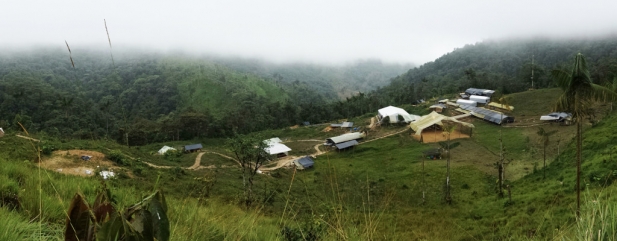Archived article
Please note that tax, investment, pension and ISA rules can change and the information and any views contained in this article may now be inaccurate.
Copper explorer SolGold confident of ‘world class’ project status

The boss of copper miner SolGold (SOLG) has a message to everyone who has doubted the quality of its assets and management capabilities: ‘Ignore us at your peril as we are coming.’
Chief executive Nick Mather says SolGold is building an integrated exploration and development business ‘that will rival the world’s biggest copper companies’.
That’s quite a claim from an exploration business which doesn’t even have a resource statement on its project. SolGold is currently valued at £561m and is many years away from generating revenue.
Over-confidence by a CEO is generally a negative sign in the world of investing. However, this boss insists he has every reason to believe his company is far superior to most other mining exploration firms on the stock market.
Why is the CEO so bullish?
SolGold owns 85% of the Cascabel copper/gold porphry project in Ecuador. Drill results from the project have been phenomenal in terms of quality. Mather claims 10 of the 39 holes so far drilled contain ‘world class’ intersections of continuous copper and gold mineralisation.
If you’re not familiar with mining, a project with continuous mineralisation over 100 metres and 1% copper equivalent (copper plus gold valued added together) or better is generally considered to be high quality.
Six of SolGold’s drill holes found more than 1,000 metres of continuous copper mineralisation and its best copper equivalent grades are generally between 0.9% and 1.1%. You can now see why Cascabel is a very exciting project. Mather is hopeful the current area being worked (called Alpala) will be one of several high-quality prospects across SolGold’s licence area.
More drilling is required on Alpala to check the distribution of the mineralisation in order to create a mine plan. One analyst suggested the full drill programme will take up to five years to complete. Mather says that is nonsense. ‘We understand Alpala now. We will drill for another two years to expand it.’
The CEO also rejects suggestions that SolGold won’t be in production for another 10 years. ‘That is a rate at which a pedestrian major mining house delivers a project. We will be more aggressive due to the high grade core. The earliest we could be in production is four to five years’ time,’ reveals Mather.
Missed opportunity with listing change
SolGold last week (6 Oct) moved from AIM to London’s Main Market. Such a move is typically made when a company has reached a certain stage of maturity and wants to be seen as a more credible business.
Companies also tend to graduate to the Main Market when they’ve reached the appropriate market valuation to qualify for inclusion in one of the two main FTSE indices, being the FTSE 250 or FTSE 100.
SolGold is almost big enough for the FTSE 250 – except it won’t be entering the index any time soon. That’s something which many investors have failed to grasp, judging by comments on internet bulletin boards.
Tracker funds buy stocks which enter (or are about to enter) the FTSE 250 in order to have an accurate representation of the index’s performance. The increased demand for the stock tends to push up the share price.
For example, Sirius Minerals (SXX) saw its share price jump by 32% over six weeks after moving from AIM to the Main Market earlier this year.
SolGold is different. It doesn’t have the right type of listing to qualify for the FTSE 250 so tracker funds won’t automatically buy its stock and drive up the price. The miner actually saw its share price fall by 6% on its first day on the Main Market.
In order to qualify, SolGold will need to upgrade from a standard to premium listing. Matthey says it is something that will be considered in the future.
 Why some large investors aren't interested ... yet
Why some large investors aren't interested ... yet
The lack of a resource statement and any form of feasibility study will act as a deterrent for many institutional investors to be interested in the stock, despite its large market valuation.
At the moment its biggest shareholders include an investment firm associated with Mather, a mining investment house which owns part of Cascabel and an Asian trading firm. Two other large shareholders are miners Newcrest and Guyana Goldfields. Importantly, stresses Mather, neither miner has a stake at the asset level.
Commenting on Newcrest’s involvement, Mather says: ‘They provide great technical support and advice on an informal basis. But they don’t have any rights apart from the ones that come as a shareholder. They also cannot use their 14.5% stake in SolGold to block any takeover attempts.’
He claims SolGold is ‘getting a lot of interest from other majors’ and from funds and banks. ‘Our strategy is to stay well cashed up.’ SolGold had A$89.3m (£49.9m) cash as of 30 June 2017.
Fighting off interest from majors
A year ago BHP Billiton (BLT) tried to derail Newcrest’s plans to invest in SolGold when it made a proposal to earn-in up to 70% of Cascabel.
‘BHP’s proposal was poorly structured,’ claims Mather. ‘The prospective size of the project, plus upside that could be delivered, made it a no brainer to do the work ourselves and reject BHP.’
Sovereign risk is something to watch when considering an investment in SolGold. Ecuador’s government is still developing new mining policies. Ten years ago the county imposed a moratorium on mining and implemented a windfall tax, killing the industry.
Ecuador mining is now slowly coming back. ‘It’s going to be the new porphyry copper province and SolGold will have the best of it,’ says Mather, modestly.
He hopes the much-awaited resource statement due later this year on Cascabel will finally give people something to get their teeth into; and start looking at SolGold more seriously.
Important information:
These articles are provided by Shares magazine which is published by AJ Bell Media, a part of AJ Bell. Shares is not written by AJ Bell.
Shares is provided for your general information and use and is not a personal recommendation to invest. It is not intended to be relied upon by you in making or not making any investment decisions. The investments referred to in these articles will not be suitable for all investors. If in doubt please seek appropriate independent financial advice.
Investors acting on the information in these articles do so at their own risk and AJ Bell Media and its staff do not accept liability for losses suffered by investors as a result of their investment decisions.
Issue contents
Big News
- Streamlined BAE aims to fly
- Capita announces new CEO
- Online orders heat up Domino’s shares
- Can exploration make a comeback after North Sea oil discovery?
- Where next for the UK stock market?
- Energy price cap threatens Centrica’s earnings and dividend
- Polar launches new megatrends fund
- Christmas comes early for Cranswick

 magazine
magazine









